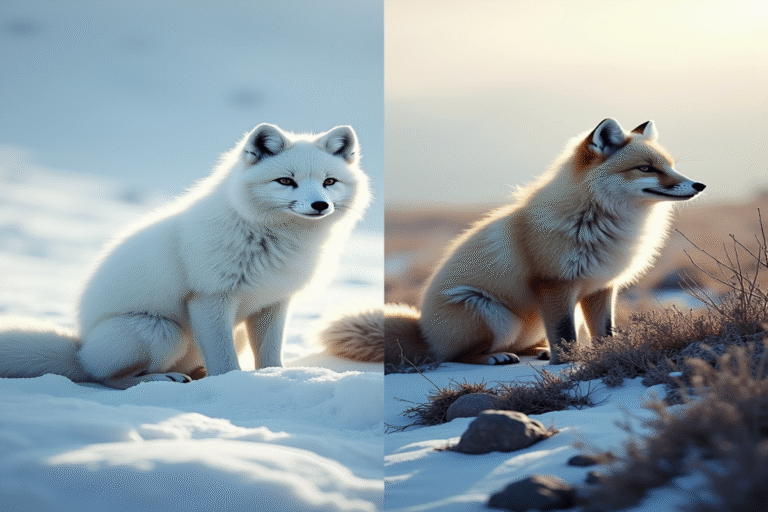The Amazing Science Behind Arctic Fox Color Changes
Arctic foxes (Vulpes lagopus) possess one of nature’s most remarkable adaptation mechanisms: the ability to completely change their fur color between seasons. This is not just a simple wardrobe change; it is a sophisticated biological process that has evolved over thousands of years to ensure survival in one of Earth’s harshest environments.
From Snow White to Earth Tones: A Complete Transformation
During the winter months, arctic foxes have a pristine white coat that blends perfectly with the snowy landscape. As spring arrives and snow begins to melt, an extraordinary transformation occurs. The white fur gradually sheds and is replaced by brownish-gray summer fur, providing excellent camouflage among the rocks, plants, and soil of the tundra.
This dramatic seasonal change is one of the most complete color transformations in the mammal world. Unlike some animals that merely lighten or darken their existing coat, arctic foxes undergo a total color replacement through molting.
The Biological Mechanisms: How Does It Happen?
The color change is primarily controlled by photoperiod—the length of daylight hours. As daylight changes with the seasons, it triggers hormonal changes within the fox’s body. These hormonal shifts activate the shedding of old fur and growth of new fur with different pigmentation.
The key hormone involved is melatonin, which is produced in the pineal gland in response to darkness. When days shorten in autumn, increased melatonin production triggers the development of white winter fur. When days lengthen in spring, decreased melatonin allows for the growth of the darker summer coat.
Interestingly, the white winter fur isn’t actually pigmented white—it lacks pigment altogether. The fur shafts are hollow and filled with air, which scatters light in all wavelengths and creates the appearance of white. This structure also provides superior insulation, keeping the fox warm in temperatures as low as -50°C (-58°F).
Evolutionary Advantages: Why Change Colors?
The main advantage is camouflage. The white winter coat makes arctic foxes nearly invisible against the snow, while their summer brown-gray coloration helps them blend with the tundra landscape. This camouflage serves two critical purposes:
- Hunting success: Arctic foxes prey on small rodents, birds, and eggs. Being well-camouflaged allows them to approach prey undetected.
- Predator avoidance: It helps protect them from larger predators like wolves, polar bears, and golden eagles.
Not all arctic fox populations change to white. In coastal Iceland, where snow rarely accumulates, the foxes remain bluish-gray year-round, demonstrating that this adaptation is specifically tied to environmental conditions.
Genetics and Variations
The color change ability is genetically determined, with two main color morphs:
- White morph: Changes from white in winter to brown in summer (most common).
- Blue morph: Remains bluish-gray year-round but appears lighter in winter.
These differences are controlled by a gene called MC1R (melanocortin 1 receptor), with the blue morph resulting from a recessive allele. This genetic diversity ensures population resilience across different Arctic microclimates.
Arctic Fox Adaptations Beyond Fur Color
The seasonal fur change is just one remarkable adaptation these small predators have developed:
- Compact bodies, short legs, and small ears minimize heat loss.
- Fur-covered foot pads provide insulation and traction on ice.
- The ability to lower metabolic rates during times of food scarcity.
- Exceptional hearing that allows them to detect prey moving under snow.
Together, these adaptations make arctic foxes highly suited to their harsh environment, where winter temperatures can reach extreme lows and food can be scarce.
Climate Change Challenges
As global warming alters Arctic ecosystems, arctic foxes face new challenges. Warming temperatures disrupt the timing of seasonal color changes, potentially leaving white foxes exposed on increasingly snowless landscapes—a dangerous mismatch that makes them more visible to predators.
Additionally, climate change is allowing red foxes to expand their range northward, creating competition for the arctic fox. Red foxes are larger and can outcompete arctic foxes for food and territory, putting further pressure on arctic fox populations.
Scientific Research and Discoveries
Recent studies have revealed fascinating details about this seasonal transformation:
- The complete fur turnover takes about 8-10 weeks.
- The transition is triggered by changes as small as a few minutes in daylight.
- Scientists have identified specific genes that activate during the molting process.
- Some foxes living in transitional areas have evolved intermediate color patterns.
Researchers continue to study arctic foxes to better understand the molecular mechanisms behind these changes, which could have applications in fields from materials science to medicine.
The Bigger Picture: Color Change in Nature
The arctic fox is not alone in its color-changing ability. This phenomenon, called seasonal polyphenism, occurs in various species:
- Snowshoe hares change from brown to white in winter.
- Stoats (ermines) develop white winter coats.
- Ptarmigans (Arctic birds) also change plumage seasonally.
However, the arctic fox’s transformation is among the most complete and best adapted to its environment, representing one of nature’s most elegant solutions to seasonal challenges.
Conclusion
The arctic fox’s ability to change fur color represents an evolutionary masterpiece—a perfect example of how natural selection shapes species to fit their environment. As climate change threatens to disrupt this delicate balance, understanding these adaptations becomes increasingly important for conservation efforts.
This remarkable color-changing capability reminds us of nature’s incredible ingenuity and the fascinating scientific principles that govern life in extreme environments. The arctic fox, with its seasonal transformations, stands as a symbol of adaptation and resilience in our changing world.





